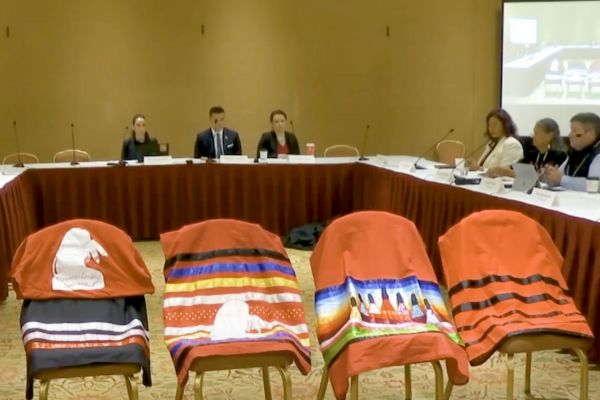
- Details
- By Elyse Wild
ALBUQUERQUE, N.M. – The U.S. Department of Justice announced Wednesday it will be dedicating new resources to address the Missing or Murdered Indigenous Persons (MMIP) crisis.
Under a new Missing or Murdered Indigenous Persons (MMIP) Regional Outreach Program, the DOJ will permanently place ten attorneys and coordinators in five regions across the United States to assist in the investigation of unsolved MMIP cases and related crimes while promoting collaboration among federal, Tribal, local and state law enforcement as well as non-governmental stakeholders. The five regions include the Northwest, Southwest, Great Plains, Great Lakes, and Southeast Regions, and MMIP personnel will be located within United States Attorneys’ offices in the Districts of Alaska, Arizona, Eastern Washington, Minnesota, New Mexico, Northern Oklahoma, Oregon, South Dakota, and Western Michigan.
Native American communities experience high rates of assaults, abduction and murder. According to data from the Center for Disease Control and Prevention, Native women living on reservations are murdered at a rate ten times higher than the national average. Layered jurisdiction, lack of collaboration between law enforcement bodies and systemic apathy have led to thousands of unsolved cases in Indian Country. While there is no comprehensive data on MMIP, the Bureau of Indian Affairs estimates there are 4,200 unsolved MMIP cases.
U.S. Attorney General Merrick B. Garland acknowledged that tribal communities have been left reeling from the crisis.
“This new program mobilizes the Justice Department’s resources to combat the crisis of Missing or Murdered Indigenous Persons, which has shattered the lives of victims, their families, and entire Tribal communities,” Garland said in a statement. “The Justice Department will continue to accelerate our efforts, in partnership with Tribes, to keep their communities safe and pursue justice for American Indian and Alaska Native families.”
The new regional outreach program was announced during Wednesday’s Not Invisible Hearing Commission Hearing in Albuquerque, N.M., where Tribal officials, Native leaders, law enforcement and government officials convened for panel discussions and to witness testimony from Native American community members impacted by the MMIP crisis.
The hearing opened with a prayer by Gil Vigil, an enrolled member of the Tesuque Pueblo and executive director of Eight Northern Pueblos Council. Commission members were seated around four chairs, each chair donning a red skirt in honor of those who have been murdered or are missing. Following the prayer, the commission held a moment of silence members spoke the names of victims, including Daisy Mae Heath of the Yakama Nation, who went missing in 1987 and whose remains were identified in 2008.
The hearing is one of seven held this year across Indian Country as the 37-person Not Invisible Act Committee develops recommendations on improving intergovernmental collaboration on violent crimes in Indian Country and providing resources for survivors and victims’ families. Information gathered at the hearings will be part of the commission’s final report to Secretary Haaland, Attorney General Merrick Garland and Congress in October.
At Wednesday’s hearing, New Mexico State Senator Linda Lopez underscored the United States’ trust responsibility to tribal nations and the need to put federal resources behind the MMIP crisis.
“The federal legislatures need to own up to the duty between the federal government and our reservations and Indian Country to make sure we are providing funding to adequately do the work for those who are missing,” Lopez said.
Elizabeth Hidalgo Reese, a member of Nambé Pueblo and senior policy advisor for Native American affairs at the White House, acknowledged
the victims and families present at the hearing and how critical their testimony is to create solutions to the crisis.
“These hearings are so important,” Hidalgo Reese said. “Neglect and invisibility are too often the cause or enable violence in our communities ... we need to understand this problem from every angle. We need to explore every possible solution, so we need to hear from all of you.
More Stories Like This
Native News Weekly (August 25, 2024): D.C. BriefsUS Presidents in Their Own Words Concerning American Indians
Monday Morning (November 24, 2025): Articles You May Have Missed This Past Weekend
Navajo Nation President Nygren Defends Record, Says Speaker’s Actions ‘Disgraceful’ and Politically Driven
Native News Weekly (November 23, 2025): D.C. Briefs
Help us tell the stories that could save Native languages and food traditions
At a critical moment for Indian Country, Native News Online is embarking on our most ambitious reporting project yet: "Cultivating Culture," a three-year investigation into two forces shaping Native community survival—food sovereignty and language revitalization.
The devastating impact of COVID-19 accelerated the loss of Native elders and with them, irreplaceable cultural knowledge. Yet across tribal communities, innovative leaders are fighting back, reclaiming traditional food systems and breathing new life into Native languages. These aren't just cultural preservation efforts—they're powerful pathways to community health, healing, and resilience.
Our dedicated reporting team will spend three years documenting these stories through on-the-ground reporting in 18 tribal communities, producing over 200 in-depth stories, 18 podcast episodes, and multimedia content that amplifies Indigenous voices. We'll show policymakers, funders, and allies how cultural restoration directly impacts physical and mental wellness while celebrating successful models of sovereignty and self-determination.
This isn't corporate media parachuting into Indian Country for a quick story. This is sustained, relationship-based journalism by Native reporters who understand these communities. It's "Warrior Journalism"—fearless reporting that serves the 5.5 million readers who depend on us for news that mainstream media often ignores.
We need your help right now. While we've secured partial funding, we're still $450,000 short of our three-year budget. Our immediate goal is $25,000 this month to keep this critical work moving forward—funding reporter salaries, travel to remote communities, photography, and the deep reporting these stories deserve.
Every dollar directly supports Indigenous journalists telling Indigenous stories. Whether it's $5 or $50, your contribution ensures these vital narratives of resilience, innovation, and hope don't disappear into silence.
 The stakes couldn't be higher. Native languages are being lost at an alarming rate. Food insecurity plagues many tribal communities. But solutions are emerging, and these stories need to be told.
The stakes couldn't be higher. Native languages are being lost at an alarming rate. Food insecurity plagues many tribal communities. But solutions are emerging, and these stories need to be told.
Support independent Native journalism. Fund the stories that matter.
Levi Rickert (Potawatomi), Editor & Publisher

